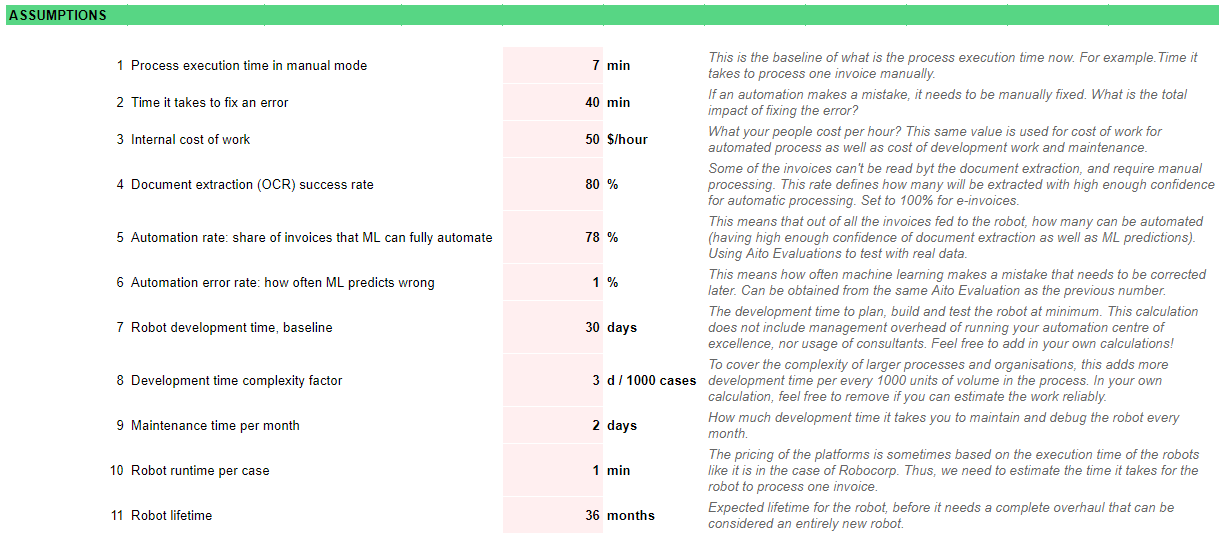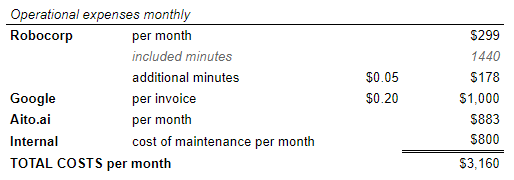The business case for intelligent automation
Tommi Holmgren
CPO
September 23, 2021 • 4 min read
With intelligent automation on the rise, I wanted to share a practical example of the cost and business case calculation, paying particular attention to the cost of the automation stack. Compared to traditional rule-based RPA workflows, intelligent automation introduces the need for machine learning, which adds its intricacies to the implementation and the business case calculation.
I'm using an example case of automating purchase invoices to the ERP or accounting system, a typical case among Aito customers. For the article, I have made numerous simplifications. The real-life might be a tad more complex.
The automation stack
There are countless tools and platforms to make this happen, and choosing the right building blocks will help make the automation project a success. In my example, I build the case with tools that I am familiar with and have access to the validated pricing details to show the business case calculation.

Our "hands" will be Robocorp - an automation platform based on an open-source stack. It's cloud-native and has the necessary tools for automation ops.
We will also need "eyes" to extract data from invoices. For that purpose, we'll use Google Procurement DocumentAI, which is still in restricted access mode at the time of writing but contains an exciting invoice parser.
Finally, we'll use Aito.ai as the "brains" of our automation and take care of the predictions, e.g. general ledger codes, tax codes and cost centres based on extracted invoice data.
Grab the template
Get a copy of the Google Sheets template here, and make a copy (File → Make a copy) for yourself to edit!
It has two main elements: Assumption and Profitability calculation. By default, edit only the light pink cells to change the assumptions and amount of invoices.
Assumptions
We need to make some general assumptions. The list is quite long, and I will let you explore it in detail in the template.

I want to highlight that there are two critical percentages in play: document extraction success rate and ML predictions automation rate.
Some of the invoices can't be read and require manual processing. For example, I am assuming 80% coming out of document extraction with high confidence, and the rest fall into manual processing. In reality, there is often an intermediary process of correcting the extracted document, and thus there are some automation benefits in these cases. For simplicity's sake, I am not including these benefits. In the markets where invoicing is electronic, you can set the success rate to 100% and remove the cost of the document ai component.
Next up is the automation rate, which I set to 78%. It means the share of invoices that get high confidence predictions from ML. Aito's Console can give the estimate of this figure after you drop in a historical dataset. The result will look like this:

Notice that you often have multiple prediction targets per case; for example, you need to predict general ledger code, tax class, cost centre and a reviewer. As a result, you need to look at these prediction targets as a whole: how often all of the given targets are predicted with high enough confidence for one given invoice. It's prevalent for the automation rate to drop lower as you add more prediction targets.
Assumptions are where you will most often go wrong, not in the simple maths that follow. So please review your numbers and then see how this works out in calculations.
Profitability calculation
The template illustrates the profitability with several different invoice volumes, but I'm walking through the logic with 5000 invoices per month only.
Operational expenses
Monthly operational costs come mainly from the platforms in use and the maintenance work required. The calculation is simple.

With the above elements, the monthly cost of running the automation with 5000 invoices is $3160.
Efficiencies created
Now on the benefit side!

As explained with the assumptions earlier, only a certain percentage of OCR is good enough, and out of those only, a certain percentage of ML predictions are good enough. After all this, our calculation shows that our robot would automate 3120 invoices. That's about 62% of the total volume. We are on par based on my experience from customer cases.
Using the time saved (minus the time it takes to fix errors) and the cost of work, the value of the saved time is thus about $17k per month.
Profitability
Putting the previous two together, we can calculate monthly and lifetime profitability.

Estimating the development time and cost for the automation (45 days, $18k), we can see that the initial cost will be covered in the second month of operation. Thus, in the entire three year lifetime, the savings are close to $500k!
Apart from the monetary benefit, automating mundane tasks often lets staff focus on tasks that produce greater benefits for the company. Factors like increased job satisfaction should be assessed separately, but are outside of the scope of this article.
Is it worth automating?
My favourite metric is per invoice profitability (over the total cost of ownership) at different monthly invoice volumes. That shows what makes sense and what does not.

With the stack we are using, the profitability threshold is somewhere at 500 invoices per month. And to get value out of the automation, I claim you should probably operate closer to 1000 invoices per month.
Of course, this is a calculation with my chosen stack and for one use case. Next, you can take the template and make it your own. There are loads of tools in the market to try; completely free open source automation tools, free OCR engine and enterprise-grade RPA platforms. In some cases, you might not have resources internally to build the bots, so you need to account for higher costs of development and maintenance.
Fill in your numbers, and see if you can make the robot a success!
Back to blog listAddress
Episto Oy
Putouskuja 6 a 2
01600 Vantaa
Finland
VAT ID FI34337429